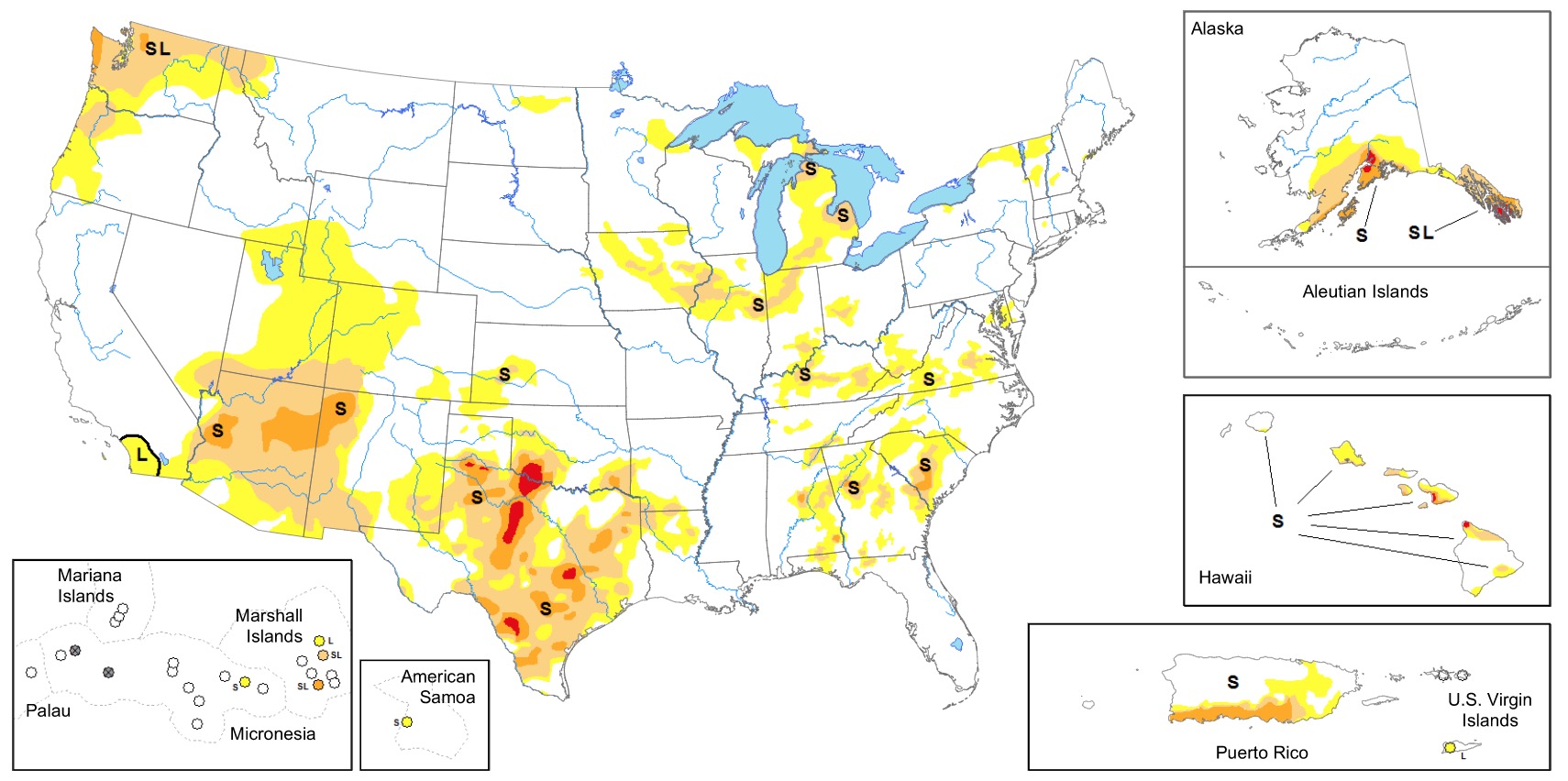Drought
Droughts occur throughout North America and in any given year at least one region is experiencing drought conditions. We usually don't think of droughts in the same way as other natural disasters, such as floods or hurricanes. For example, no one knows for sure how severe a drought will be - until the rains return. But droughts can be more costly than other natural disasters.
- Prepare for drought
- Weekly drought map and monitor, from climate.gov
- During a drought
- More about drought
Prepare for a drought
In general, adopt or change to practices, techniques, and equipment that use less on water or work well regardless of drought conditions before you need them. This makes drought conditions easier to bear and helps reduce demand on existing supplies.
At home:
- Use irrigation systems that deliver water most effectively, such as laying drip hoses instead of above-ground sprinklers.
- Water the lawns and gardens in the early morning or evening to minimize evaporation. Smart irrigation timers can make it easy to remember!
- Use plants that are native to your area and that do well under a wide variety of local conditions or need less water to thrive.
- More outdoor and landscaping tips to save on water.
- Use water-efficient fixtures in your kitchen, bath, or laundry so you will need less water later on.
In commercial buildings and schools:
Commercial buildings use a tremendous amount of water every day and require water for employees and a wide variety of operations. Learn more about saving water and water efficiency in commercial buildings.
For communities:
Drought Response and Recovery for Water Utilities. Find worksheets, best practices, videos, and key resources for responding to drought emergencies and building long-term resilience.
EPA's Creating Resilient Water Utilities (CRWU) initiative helps drinking water, wastewater, and stormwater utilities to understand the impacts of climate change and take actions to adapt to anticipated changes.
Water reuse strategies may offer an opportunity to improve resilience by developing an alternative supply of water.
The Fed FUNDS website provides information about federal funding for water and wastewater utilities in natural disasters. This includes funds from FEMA, HUD, and the USDA. Assistance is also available from EPA's State Revolving Fund (SRF) programs.
- Addressing and Mitigating Drought with the Drinking Water State Revolving Fund
- Funding Drought Resiliency with the Clean Water State Revolving Fund
Ways to improve water efficiency:

EPA's WaterSense program helps consumers, businesses, or communities identify water-efficient products, homes, and programs. Look for the WaterSense label to identify products and programs that save water, save money on utility bills, and promote innovative manufacturing.
- Ideas for Homes
- Ideas for Commercial Buildings
- Ideas for Outdoors
- Ideas for Kids
- More about WaterSense
During a drought
Always observe state and local restrictions on water use during a drought. If restricted, for example, do not water your lawn, wash your car, or other non-essential activities, to help ensure there is enough water for essential or emergency uses. WaterSense has information on additional actions you can take during a drought. Contact your state or local government for current information and more suggestions.
Apply chemical pesticides and fertilizers carefully - read the label. Chemicals, especially those applied in dry form, can stay dry in a drought and be blown by the wind to sensitive areas. If over-applied, they can accumulate and eventually wash away in concentrated amounts when the drought ends, possibly causing greater harm. Always follow the directions on the pesticide label. More about pesticides, health, and safety.
Be aware of dust-related health problems. Extended periods of dry weather can increase dust or other fine particles in the air we breathe, and possibly cause or worsen existing health problems. How air-borne particle pollution (smoke, soot) affects health.
- Learn about Air Cleaners and Air Filters in the Home
- Choose carefully: Ozone Generators that are Sold as Air Cleaners
More related to drought
How higher temperatures relate to drier conditions and wildfires.
A drought can make hot weather feel even more severe. Be sure you are prepared to protect yourself and others during hot, dry spells. More about extreme heat.
EPA carries out water research focused on building drought resilience and water conservation.

Related Info
Info on drought.gov:
General information about drought conditions and predictions
National Drought Resilience Partnership
National Fire Center: Wildfire information

